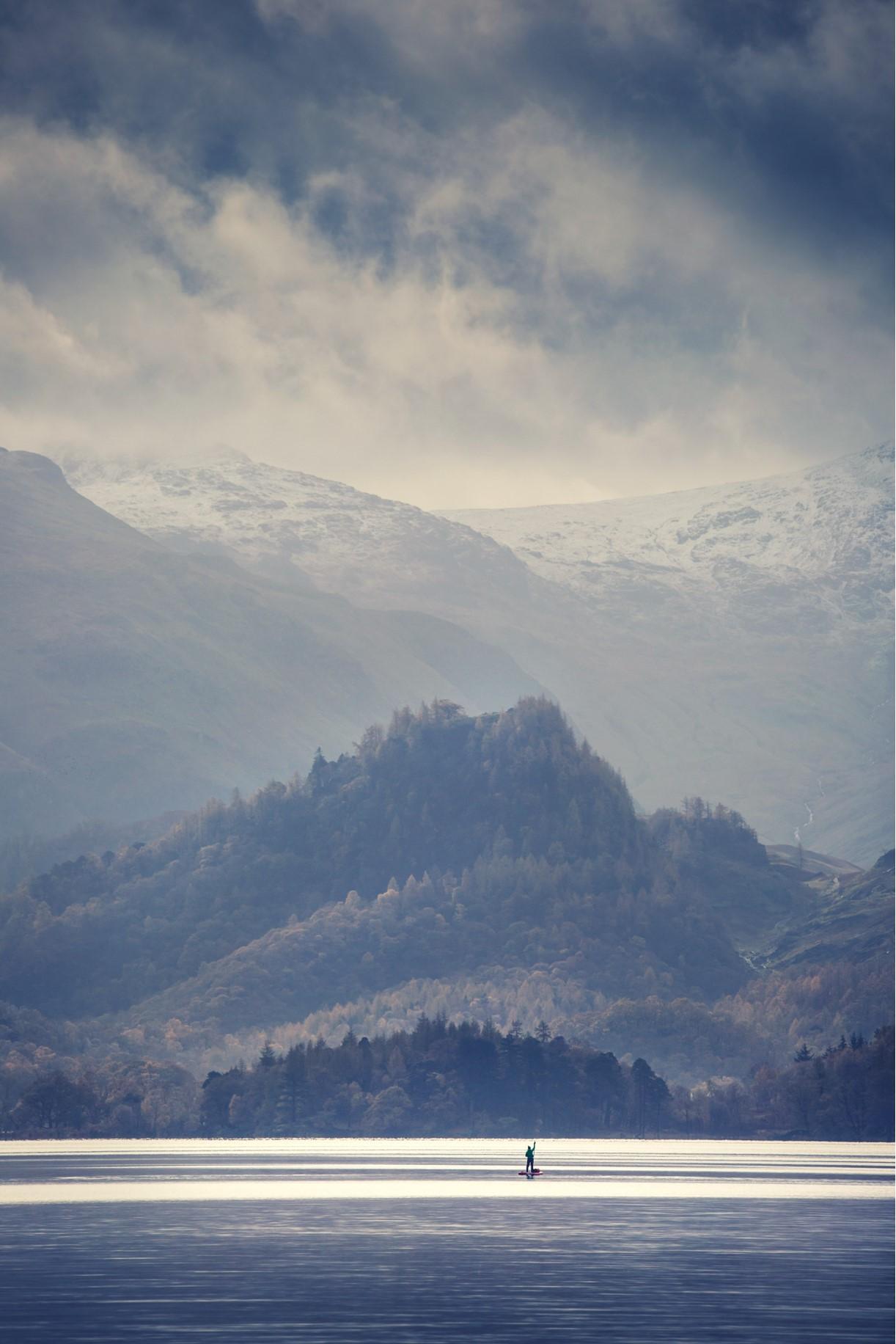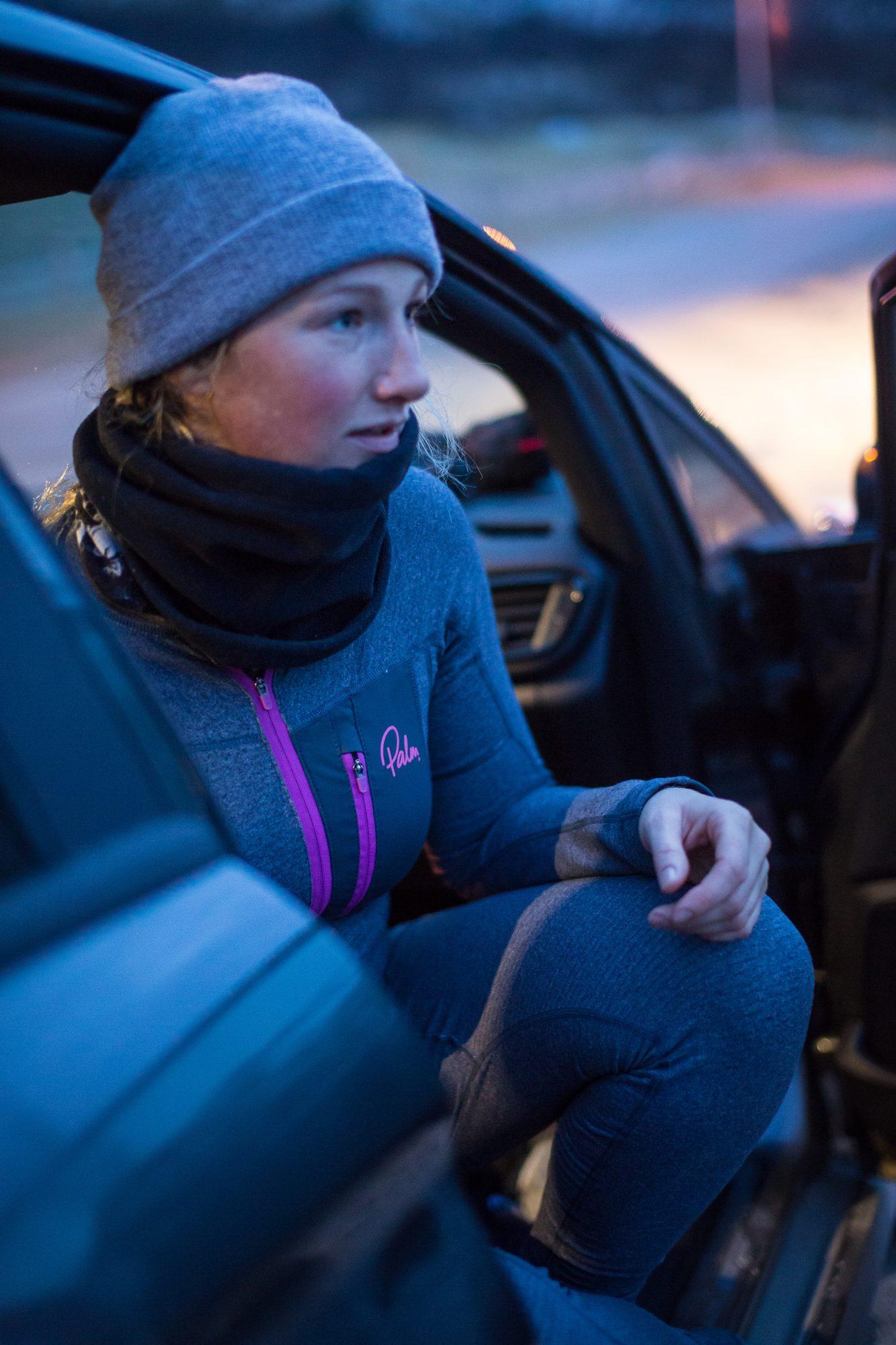Paddling this morning as snow fell around me, I realised just what an opportunity winter gives us for training. I love long paddles, but the winter seas and my poor circulation don’t lend themselves to a particularly enjoyable winter SUP expedition. So I generally save my bigger trips for the summertime. Over several years of SUP expeditions, and injury, I’ve really come to appreciate the importance of being prepared physically and mentally for the challenge, and I wanted to share a few things I’ve learnt along the way. Here are my top ten tips:

1. Warm up properly
Warm-up properly. In winter, our bodies and muscles are colder to start with. A full warm-up, mobilising each joint from your neck to your toes, is really important to avoid injury.
2. Perfect your technique
Get yourself a qualified SUP instructor to help you improve your technique. Honing your technique is really important if you’re planning to paddle long distances. Winter is a great time to go back to basics and make sure you’re not setting yourself up for injury. The amazing Marie Buchanan recently helped me with my technique, and it’s so reassuring to know that the paddle stroke I’m adopting now is correct.
3. Be adaptable to training locations

It’s harder to train consistently on the ocean during the winter, when storms, big swell and strong winds batter the coastline. When conditions allow, it’s still great to head to the sea, but it’s worth finding an inland body of water too that you can more consistently and safely train on.
I’m currently training a lot in the Lake District, where enclosed lakes are safer in marginal conditions, and some are even sheltered from prevailing winds. I think it’s important too to mix it up a bit. If that means paddling on different lakes, please make sure to wash your kit and board down appropriately between sessions to avoid the spread of non-native and invasive species between places.
Stronger winds don’t always need to stop you getting out, I sometimes purposely train into the wind; it acts almost like a treadmill! It’s important to be properly warmed up and fit enough for this as you will be putting extra strain on joints and muscles, so only do this after a period of building up strength so as not to get injured.
4. Choose kit carefully

You might be getting a sweat on, but in the winter it’s still really important to wear the right kit to stay safe, as you’re prone to cooling down very quickly. Hypothermia can be a real threat, particularly when paddling on the sea. My core winter kit includes a windproof jacket as standard (I love the Terek as it’s also breathable), neck scarf to reduce drafts and act as a hankie as needed, a hat, and a decent set of thermals under a pair of Atom pants. I am a huge fan of the Tsangpo onesie as it keeps me super warm but also wicks sweat, so whether I’m going at a leisurely pace or really going for it, it works brilliantly. If I’m going slower I’ll layer up a Tsangpo gilet on top too.
5. Mix up training sessions
I’m by no means a personal trainer, but what I’ve found works best for me is to mix up the sessions I’ll do in a week. This has taken me a while to figure out what I need, so you might want to work with a PT on this initially. Mix up the duration and effort of sessions, and be specific about what you’re aiming for before going out on the water. I like to add in an interval session once a week which can be shorter (forty-five mins to an hour) where I’ll do a short burst at 80-90% effort, followed by an active recovery interval at moderate pace, and then continue repeating these for the duration. I really like doing these to music – I’ll put on a great playlist (OK so it’s normally Taylor Swift) and paddle one song at full effort, the next at moderate effort to recover my breathing rate. This is a great way to build cardio fitness, and strength, when you don’t have heaps of daylight hours to just go for a mega long paddle. Make sure to warm up first – the initial fifteen mins I’ll normally spend easing into it before the intervals begin.
6. On land training
This has become a much more important part of my routine recently, and winter is a brilliant time to get into a routine here because, let’s be honest, nobody wants to be in the gym in the summer. I do a combination of at-home HIIT, weights and yoga sessions throughout my week to support my SUP training, and to build strength and stability around my joints. This began as injury rehab but I’m really starting to see how vital it’s becoming in keeping me injury-free. It’s not always the most enticing prospect, but find a way to make it fun! I’ve got a good app called Centr which has great workouts and also ace meal plans, and I can highly recommend following Andy Blake @blakeybayfitness on Instagram for live workouts and strength, yoga and fitness advice. His shoulder rehab programme has helped me so much, and he’s a great PT and really fun person to be around. I also love Yoga with Adriene on YouTube.
7. Other sports
I personally think it’s important to mix it up a bit. I’m really conscious of not engaging in too much other stuff in case of injury. For example, I would love to join a football club believe it or not but I just can’t currently justify the really high injury risk in the sport which could really stuff up my expedition plans. However I do make sure I surf, kite surf (in manageable conditions), swim, run and ride my mountain and road bikes often alongside paddling. These are great for cardio, but also for my mental health. I don’t want everything I do to have to have a purpose behind it, sometimes you just need to do things to have fun! So I build these less structured sessions into my week’s plan too. Make sure your plan can be flexible – if the surf is pumping or it’s just snowed and there’s a hill to slide down, for me, it’s important to know I can change my training plan to include fun stuff like that.
8. Nutrition
I’m not a nutritionist, so please do follow advice from professionals here, however, I am very aware of my need for high-quality protein as I follow a mostly plant-based diet. I can personally recommend Vivo Life for their plant-based protein which is really filling and full of high-quality ingredients. They also package it in compostable packaging and plant a tree for every order. If you’re heading out for a big session, I also recommend taking a hot drink on the board with you as well as water, and if I’m out for more than a few hours, I’ll normally take a hot meal. This might sound over the top, but I’ve bonked more than once during long days on the water (run out of energy) and it’s scary and avoidable. I use Klean Kanteen’s insulated food canisters and flasks – they’ve been a game-changer since I started really acknowledging the need to eat and drink well on the board.
9. Mental endurance
Mental endurance is important too! If you’re finding you’re getting bored when out paddling long distances, all the more reason to do it. We are so accustomed to shying away from discomfort; what is really empowering instead is being able to sit with it, acknowledge that hours on end on a SUP can be tedious at times, but that you have a bigger goal, and embracing that challenge is a part of that. I wrote a blog about mastering the endurance mindset that you might find helpful.
10. Get inspired

Snuggle up with a good book, film or webinar. As exciting as it is to continue exploring the great outdoors in winter, the long dark nights offer a good opportunity to learn and get inspired. I personally recommend checking out the Waterskills Academy webinar series which can be found here. We’ve made several paddling films over the years too – from circumnavigating the Isle of Skye, to paddling the length of the UK, to following the River Severn from Source to Sea, to paddling under the Northern Lights in the Arctic! You can find all of these and more here.
I hope you find some exciting opportunities in winter to enjoy experiencing the water in a different way, and to get you on the right foot for next year’s adventures. Have fun!